Therefore, garnet is much more than an aesthetic gemstone because of which people have always valued it for being a deep red gemstone; rather, garnet has been used as a precious gemstone for a very long time because of its powerful energy and the emotional effects it creates. Being a symbol of passion, garnet is a protective gemstone that makes a person positive.
Nowadays, garnet is still appreciated not only for its eternal beauty but also for all the good qualities it brings to a person’s mind, body, and spirit. This article focuses on the most significant advantages of the garnet gemstone, its spiritual significance, and why this is one of the most important gemstones.

What Is a Garnet Gemstone?
It is a naturally occurring gemstone that comes in all the colors of the rainbow, but includes varieties such as red, green, orange, and purple. Of course, probably the most famous and common variety of garnet would be the deep red garnet. This gem is strongly associated with the root chakra, which is responsible for handling issues of stability, grounding, and survival.
Traditionally, garnet has been attributed with powers for protection from travel and defense against negative energy, plus building inner strength. Most of the ancient civilizations employed garnet in one way or the other for safety reasons to achieve success.
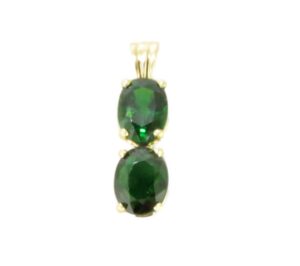
Garnet Gemstone Benefits
1. Ignites Passion and Inner Strength
Among the most well-recognized benefits that this garnet gemstone can offer in one’s life is the ability to motivate and inspire passion. It is a motivating gemstone that greatly encourages confidence, determination, and emotional courage in a person. This works very effectively for people who feel stuck with a sense of being uninspired or emotionally drained.
Garnet works to align an individual with their intention and want by stimulating the root chakra; hence, garnet rejuvenates one’s life, searching for their goals.
Key effects include:
- Boost confidence & self-esteem
- Increased expression of emotions
- More deeply romantic and personal ties
2. Offers Powerful Protection
The garnet has been considered a protective stone for a very long time. Ancient adventurers and fighters used to wear an amulet of garnet to protect them from any harm and negative influence. Till today, garnet is believed to create a protective shield that guards a wearer against negativity, fear, and imbalance of emotions.
This stone gives off grounding energy; hence, this crystal works best with a person working under stressful, uncertain, or perhaps tumultuous situations.
3. Attracts Positive Energy and Success
The important garnet gemstone attribute is that it attracts positivity and negativity into an individual’s life, which, in general, is negative in nature. Garnet amplifies discipline, focus, and perseverance, which in a professional environment are considered necessary when a person aims to achieve success.
People who possess garnet usually relate that they become more attuned to their goals in such a manner that opportunities and abundance flow into their lives with ease.
4. Supports Emotional Healing and Balance
This is a very grounding crystal that works to heal shock and trauma from the past, negative emotions, and self-doubt. Garnet encourages healing by replacing fear with security and confidence.
On the other hand, the garnet can be soothing and empowering, a relief from anxiety, a broken heart, or emotional exhaustion.
5. Boosts Physical Energy and Vitality
Traditionally, garnet jewelry is believed to have a connection with a stone that symbolizes physical energy and strength. Garnet is supposed to make sure all the energy in the body is flowing in a good manner, thus increasing one’s level of physical energy. Even though garnet does not have any medical properties whatsoever, people wear it because of its assumed capability to make a wearer more energetic and balanced.
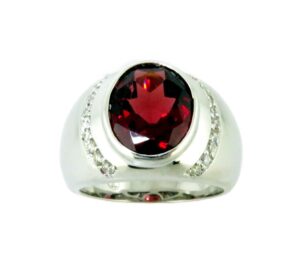
Garnet and Astrology Benefits
Garnet, in relation to astrology, is associated with energies from Mars and Saturn; hence, it should serve very well for strength, discipline, and courage. Garnet is recommended for astrologers with the birth signs of Capricorn, Aquarius, Aries, and Leo.
As an added fact, it is considered to be the well-known birthstone of January because of protection, regeneration, and auspicious beginnings in life. Therefore, January-born people wear garnet to boost their confidence and achieve a balance with their emotions all year long. To gain a better insight into this birthstone’s meaning and significance, please read our complete information source on the January garnet birthstone.
How to Wear Garnet for Maximum Benefits
Putting on a garnet close to your skin would constitute a full experience of the garnet energy. Examples of garnet jewelry that place garnet energy in front of your skin include rings, earrings, pendants, and bracelets.
For best results:
- Choose high-quality, natural garnet
- Wear it set in gold or silver
- Cleanse the gemstone occasionally to maintain its energy
Who Should Wear Garnet?
Garnet is ideal for:
- Individuals seeking confidence and motivation
- People facing career or emotional challenges
- Those wanting protection from negative energy
- Anyone looking to attract passion and positivity
If wearing a garnet for astrological reasons, consulting a gemstone expert or astrologer is always recommended.
Final Thoughts
The garnet gemstone shows an amazing blend of aesthetic appeal and significance regarding exceptional quality of energy. Amplifying passion and emotional power, offering protection as well as attracting positive energy, garnet is surely a gemstone of immense eternal importance in each way.
Worn for spiritual purposes or owing to its beauty, garnet motivates confidence, stability, and personal development.
In case you are prepared to unlock the real beauty and power of garnet, look at our special range of genuine garnet jewelry at Gem Boutique-from classic to fashion designs. They are all comprehensively crafted to help you become an epitome of passion, protection, and positivity.
So have a look at our authentic garnet jewelry selection at Gem Boutique and let this fabulous gemstone make your ordinary life extra special.
Birthstones have, of course, always been favored for their beauty, but today’s meaningful gems stand for so much more than just a pretty accessory. Across the country, more and more are embracing birthstones as personal power pieces: jewelry that supports emotional well-being, motivates setting intentions, and celebrates the individuality of the wearer. Whether you relate to your birth gem through its symbolism, energy, or just color, there are endless ways to style it beyond the traditional ring.
Take your gemstone jewelry game to the next level in this guide, where you will learn how to wear your birthstone with confidence and tap into its deeper meaning.
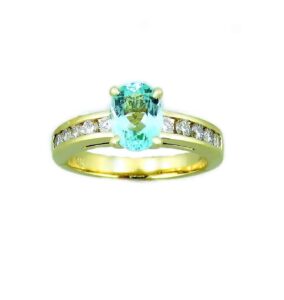
Why Birthstones Matter: A Modern Take on Their Energy and Symbolism
Birthstones have their roots in those ancient cultures that believed a certain gemstone would protect, inspire, or empower the wearer. Science does not measure “gem energy,” but many people in today’s world find meaning and intention within birthstones. Wearing your gemstone reminds you of who you are, who you’re becoming, or the qualities you’d like to nurture.
For example:
- January’s Garnet symbolizes grounding and protection.
- March’s Aquamarine represents clarity and calm.
- The peridot of August brings good luck and positivity.
- Citrine is the “merchant’s stone,” used for prosperity, in November.
Whatever your feelings on the subject of crystal healing, there’s surely something to be said for wearing something that makes you feel empowered and personal.
Beyond the Birthstone Ring: Creative Ways to Wear Your Gem
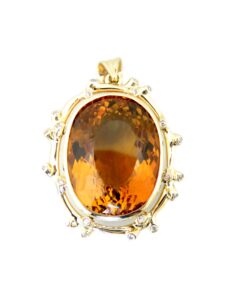
1. Birthstone Necklaces: Your Personal Power Piece
Of course, one of the most powerful ways to keep your birthstone close to your heart-quite literally and symbolically-is through necklaces: a pendant or bezel-set gemstone rests against the chest, a meaningful choice to show your emotions, set your daily intentions, or simply showcase your style.
Why this works:
- Sits near the heart chakra-for those into symbolic meaning.
- Easy to layer with other chains
- Works well with minimalist and bold jewelry.
Styling tip:
For an easy layered look, combine a dainty birthstone pendant with somewhat longer plain gold or silver chains. This will make the gemstone the star and not overwhelm your outfit.
2. Birthstone Earrings: Subtle Yet Powerful
If you prefer a look that feels polished but understated, earrings are a perfect choice. From small studs to elegant droplets, birthstone earrings offer a refined way to incorporate gem energy into your everyday style.
Why this works:
- Ideal for professional settings
- Adds natural color and sparkle near your face
- Great for people who don’t wear rings or bracelets often
Styling tip:
Try a few on and see which one works well with your skin tone. Warm stones work best with warm skin undertones. Citrine or peridot would be a really great option. Cool stones go better on cool undertones and include sapphire and aquamarine.
3. Birthstone Bracelets: Wearable Reminders
Bracelets place your birthstone where you can see it throughout the day, making them perfect for intention-setting. A glance at your wrist can remind you of your goals, mindset, or emotional balance.
Why this works:
- Ideal for daily wear
- Great for stacking
- Offers symbolic meaning with a tactile element
Styling tip:
Mix your birthstone bracelet with chains, bangles, or pearls for a chic, personalized stack.
4. Birthstone Charms: Build Your Own Story
Charms give you the freedom to create a piece that’s uniquely yours. You can combine your birthstone with charms representing your career, family, or life milestones.
Why this works:
- Completely customizable
- Great for gifting
- Can grow with your story
Styling tip:
Add charms for your children’s or partner’s birthstones. This creates a heartfelt heirloom piece you’ll cherish for years.
5. Statement Birthstone Jewelry: For Bold Personality
If your style leans bold and expressive, a statement necklace or cocktail ring featuring your birthstone lets you embrace its energy and make an unforgettable impression.
Why this works:
- Perfect for special events
- Brings gemstone symbolism to the forefront
- Ideal for people who love stand-out pieces
Styling tip:
Let your statement gemstone piece be the focal point; keep other jewelry minimal.
People Also Search: Zodiac Birthstones and Their Meanings
How to Harness the Power of Your Birthstone
Even if you’re not deeply into metaphysical beliefs, using your birthstone for intention-setting can be a grounding, meaningful practice. Here are simple ways to harness its personal power:
1. Wear It with Intention
Before putting on your jewelry each morning, pause to set an intention.
Ask yourself: What do I want to feel today? What do I want this gemstone to remind me of?
This practice transforms your jewelry from an accessory into a personal ritual.
2. Choose the Right Setting and Metal
The setting impacts how your gemstone looks and feels.
- Gold enhances warmth and energy—great for stones like ruby, citrine, and peridot.
- Silver brings a calm, soothing aesthetic—perfect for sapphire, aquamarine, or amethyst.
- Rose gold adds an element of romance and softness—beautiful on morganite, pearl, and pink tourmaline.
Choosing a metal that aligns with your style helps you connect more deeply to your piece.
3. Cleanse and Care for Your Gemstone
Keeping your gemstone clean and cared for enhances both its sparkle and its symbolic meaning. Many people cleanse their gemstone spiritually, while others simply give it a gentle cleaning routine to maintain shine.
Either way, the act of caring for your jewelry strengthens its personal value.
4. Layer Your Meaning
You don’t have to stop at your birthstone. Combine other gemstones that align with your goals, like citrine for abundance, amethyst for peace, or moonstone for clarity. This gives your jewelry deeper storytelling power.
Choosing the Perfect Birthstone Jewelry: What to Look For
When selecting birthstone jewelry, keep these factors in mind:
- Gem quality (clarity, color, cut)
- Craftsmanship
- Durability for daily wear
- Whether the piece reflects your personal style
- Ethical sourcing where possible
A well-made birthstone piece becomes a keepsake you’ll treasure for a lifetime.
Final Thoughts
Your birthstone is more than a beautiful accessory; it’s a wearable reflection of your identity, your intentions, and your personal journey. Whether you choose a necklace, bracelet, earrings, or a bold statement piece, the key is to wear your gem in a way that feels meaningful and empowering to you.
At Gem Boutique PA, we believe every gemstone carries a story, one that’s uniquely yours. Explore our birthstone jewelry collection and find the perfect piece to express your style, your energy, and your personal power.
December babies are the luckiest-whether sparkling brilliance, deep blues, or ancient meaning is your thing, few months can boast such a vibrant and eclectic assortment of birthstones. Modern options include Blue Zircon, Tanzanite, and Turquoise, but perhaps the most deeply meaningful of all traditional birthstones is Lapis Lazuli, which remains a classic.
Throughout this article, we’re going to be taking a deep dive into what a birthstone is, its history, the different color varieties available for each birthstone of December, and a few tips regarding their care. Whether you are buying jewelry or learning about your birthstone, or you’re simply fascinated with the lore of gems, this article has got you covered with all you need to know.
Why Does December Have Multiple Birthstones?
Most months are allocated one or two birthstones, but December has four. That’s because the Jewelry Industry Council and American Gem Trade Association revised the list of ‘official’ birthstones over time to reflect changes in the availability of certain gems and consumer demand for a greater range of styles and price points. Tanzanite and Blue Zircon were added due to these changes.
The result is that December has become one of the most colorful, versatile birthstone months of them all.
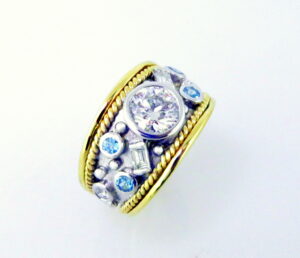
1. Blue Zircon: December’s Most Brilliant Birthstone
History & Meaning
Blue Zircon is one of the oldest minerals on Earth; some specimens date over 4.4 billion years. Long associated, through the ages, with clarity, wisdom, and spiritual protection, this mineral was thought to induce a restful sleep and to protect travelers from harm during the Middle Ages.
Color & Appearance
Of all the colors of zircon, the blue variety is still the front-runner for December. Hailed as being particularly brilliant and fiery, the Blue Zircon can stand on its own against diamonds in terms of sparkle. Colors range from an icy sky blue to a very vibrant Caribbean blue.
Durability & Care
Zircon rates 6–7.5 on the Mohs scale and is considered somewhat delicate. To keep your piece of Blue Zircon jewelry looking its best:
- Avoid strong impacts
- Store separately from harder gemstones
- Clean gently with warm, soapy water.
Why Choose Blue Zircon?
Its unmatched sparkle and striking blue tones make Blue Zircon perfect for rings, pendants, or statement earrings. If you love brilliance and vintage-style glamour, this gemstone is an excellent choice.
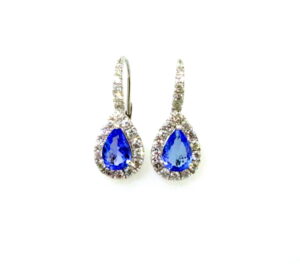
2. Tanzanite: A Rare Gem with a Modern Story
History & Meaning
Tanzanite is one of the newest varieties of gemstones, discovered in 1967 around Mount Kilimanjaro in Tanzania. Because tanzanite is found nowhere else, it has come to symbolize transformation, intuition, and new beginnings, making it a popular gift for milestone events.
Color & Appearance
It is prized for the attractive hues of blue-violet, but perhaps the most distinctive feature of all is its outstanding pleochroism, meaning that in one stone, different colors appear when viewed from different directions: blue, violet, and even shades of red.
Durability & Care
Special care is necessary because Tanzanite has a hardness of 6–7:
- Avoid ultrasonic cleaners
- Avoid wearing jewelry when doing heavy work.
- Store in a soft pouch.
Why Choose Tanzanite?
Rareness aside, the color change is so fascinating that Tanzanite is well-suited to be one of these special-occasion jewelry pieces. And being sourced from a single location, many consider Tanzanite a future heirloom gemstone.
3. Turquoise: The Ancient Stone of Luck & Protection
History & Meaning
Turquoise is one of the most ancient stones known to man and has been highly valued throughout history by various ancient cultures, from Egypt to the Native American tribes. It symbolizes good luck, healing, friendship, and protection.
Color & Appearance
Turquoise is instantly recognizable for its soothing blue-green tone. Colors can vary quite a bit from mine to mine; some are an extremely bright robin’s egg blue, while others have deeper green tones in them. Many pieces also bear characteristic matrix patterns that add to their natural beauty.
Durability & Care
Turquoise is softer than the other December birthstones and possesses a Mohs hardness of 5-6. Owing to its porosity:
- Avoid chemical exposure, perfumes, and lotions
- Avoid intense heat or sunlight.
- Clean only with a soft, dry cloth
Why Choose Turquoise?
Turquoise goes well with bohemian, southwestern, and artisan styles. When well taken care of, turquoise is perfect for everyday wear because it has plenty of historical significance and a calm energy to it.
4. Lapis Lazuli: The Traditional December Birthstone
History & Meaning
Although lapis lazuli is not included in the list of modern birthstones, this stone has been valued for thousands of years. Ancient civilizations also used it not only for jewelry and mosaics but for ultramarine pigment, too. It symbolizes the truth, inner power, and royalty.
Color & Appearance
For thousands of years, lapis has been famous for a beautiful, deep royal blue color, speckled with gold-colored pyrite and cloudy veins of white calcite. The natural inclusions bring individual characteristics to a stone, and no two stones are exactly alike in appearance.
Durability & Care
Being hard at 5–6, lapis is resistant, but sensitive to chemicals and heat; to preserve its beauty:
- Clean only with a damp cloth
- Never use steam and ultrasonic jewelry cleaners
- Store away from harder gemstones
Why Choose Lapis Lazuli?
For lovers of bold, opaque stones steeped in history, lapis is a choice of stunning beauty. In its royal blue and gold shimmer, it lends itself particularly to statement rings, beads, and talismanic jewelry.
Which December Birthstone Should You Choose?
But every birthstone of December has its own special allure:
- Blue Zircon: For brilliance, sparkle, and icy blue tones
- Tanzanite: For rarity, luxury, and color-shifting vibrance
- Turquoise: For earthy charm, history, and protective symbolism
- Lapis Lazuli: For bold color, cultural significance, and artistic style
Whether you’re selecting a birthstone gift or treating yourself, December offers an impressive range of beautiful gems to match any aesthetic.
Final Thoughts
December’s birthstones, Blue Zircon, Tanzanite, Turquoise, and Lapis Lazuli, showcase some of the most mesmerizing blues in the gemstone world. Rich in history, symbolism, and natural beauty, each stone brings its own unique story and energy. With proper care, these gems can be cherished for generations.
At GEM Boutique, we celebrate the timeless beauty of December birthstones by offering high-quality, ethically sourced gemstone jewelry designed to last a lifetime. Whether you’re searching for a meaningful birthday gift or treating yourself to something special, GEM Boutique helps you discover pieces that blend elegance, craftsmanship, and personal significance.
Celebrate the final month of the year with gemstones that shine as brightly as the season itsel,f beautifully curated and expertly crafted at GEM Boutique.
Anniversaries are time markers, but also markers of memories accrued, adversity overcome, and love deepened. Rather than choosing a predictable toaster or boring gift, why not celebrate the event with something novel and lasting: a gemstone equivalent to your anniversary year? By meshing the old list (the venerable symbolic gem or material) and the new list (a new selection for modern tastes), you have twice the ideas and the true gifting meaning.
Below, we’ll walk through key anniversary years, highlight the gemstones or materials associated with each, explore what they represent, and share tips for choosing the right piece.
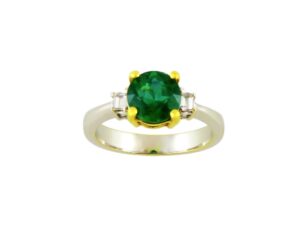
Why Gemstones (and materials) Matter
In anniversary gift-giving, the idea of associating a gem or material of gift with each anniversary exists for decades. These gems carry symbolism. A gem is not just beautiful; it stands for attributes of longevity like loyalty, renewal, strength, clarity, or passion. As an example, a sapphire (deep blue) generally represents wisdom and loyalty, emerald green represents renewal and growth, and diamond stands for endurance and radiance.
By choosing a gemstone (or substance), you’re not just providing a gift; you’re providing meaning. And by utilizing the traditional list (still followed by many couples today) and the modern list (which gives you creative choices), you now have a new, personal way to commemorate.
Early Years: Setting the Sparkle
1st Anniversary: Gold
- Traditional: Gold (symbolizing the shining, unblemished quality of a fresh marriage)
- Modern: Gold jewelry too (a convenient overlap)
A simple gold pendant or plain gold bracelet is classic and long-lasting.
2nd Anniversary: Garnet
- Traditional: Garnet (deep red, representing guardian love and passion)
- Modern: Garnet jewelry remains a considerate and enduring reminder of strong commitment and passion.
3rd Anniversary: Pearl
- Traditional: Pearl (built up layer by layer, as love accumulates)
- Modern: Crystal or glass, but these are delicate, so pearl remains the more thoughtful, longer-lasting option.
4th Anniversary: Blue Topaz
- Traditional: Flowers or fruit (cute… but fleeting)
- Modern: Blue topaz (clear, calm, communicative)
A piece of blue topaz jewelry offers warm colour, meaning (communication, clarity,) and is sensitive to eternity.
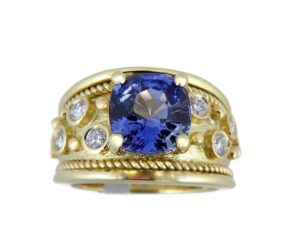
5th Anniversary: Sapphire
- Both lists converge at sapphire. A deep blue gem that represents fidelity, wisdom, and enduring love. A good anniversary to upgrade, perhaps a sapphire ring or a pendant.
The Middle Years: Strengthening & Shine
10th Anniversary: Diamond Jewelry
- Traditional: Tin or aluminium (metal of modest worth)
- Modern: Diamond jewellery. A decade later, it’s perfectly acceptable to choose brilliance. A diamond pendant, studs, or bracelet shouts “we’ve come to this stage and we glitter together”.
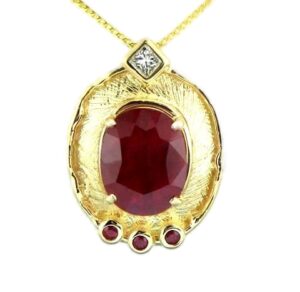
15th Anniversary: Ruby
- Traditional: Ruby (dramatic red, passion, romance)
- Modern: Watches (practical, long-lasting,) but why not have the best of both worlds with a ruby watch or jewellery?
20th Anniversary: Platinum Jewelry
- Traditional: China (sigh, again with the breakables)
- Modern: Platinum jewelry
And then the emerald (green) gemstone for renewal and rich life together. Something in emerald and platinum is a perfect choice for 20 years.
25th Anniversary (Silver Jubilee)
- Both lists: Silver. Twenty-five years are worth something that shines, that endures. Silver jewelry, modern design, or classic marks perfectly.
The Golden Years: Celebrating Big Milestones
30th Anniversary
- Traditional: Pearl returns (signifying layered history, deep union)
- Modern: Diamond (since by this time you can definitely splurge)
Pearl-and-diamond combinations are gorgeous.
40th Anniversary
- Traditional/Modern: Some lists choose ruby for the 40th anniversary, representing the enduring passion of four decades. A ruby necklace or elegant ruby ring shouts, “four decades later, I still choose you.”
50th Anniversary (Golden Anniversary)
- Gold. Fifty years together deserves something special. A gold item to order, or a piece from a high-end jewelry firm, is appropriate. The meaning is as strong as the metal with 50 years.
How to Choose the Right Gift: Personalising the Gemstone Journey
- Budget & style: Choose something within your budget and to your partner’s style. A plain pendant might suit someone more than a flashy ring.
- Quality is important: With gems, cut, clarity, colour, and setting are all significant. More so when the object is symbolically significant.
- Mix birthstones or significance: In case their anniversary stone is different from the birthstone, you may mix both. For example, an anniversary stone paired with their birthstone in a “two-stone” ring or pendant is very personal.
- Personalize your story: If there is a color that holds personal meaning to you as a couple, maybe where you met, a special place you went on vacation, or even just their favorite color, feel free to be different from the list. The lists are there as guidelines, not dicta.
- Make it about the sentiment: At the end of the day, the best anniversary gift isn’t about the price tag, it’s about showing you’ve listened, remembered, and celebrated your unique journey.
Final Thoughts
Whether your anniversary is your 1st, 10th, or 50th, the gemstone tradition unites age-old symbolism with contemporary style. From garnets and sapphires to emeralds and rubies, each gemstone speaks to the history of love’s passion, strength, and rebirth.
Each anniversary is as unique as your love at GEM Boutique, we believe. Our carefully hand-picked collection of high-end gemstone jewelry pairs classical sophistication with contemporary flair to help you find the ideal piece to celebrate your milestone in shining style.
Celebrate your love affair year after year with brilliance that will last an eternity.
November babies are blessed with not one, but two dazzling birthstones Topaz and Citrine. Both gemstones are known for their warm, radiant hues that perfectly capture the golden glow of autumn. While they may look similar at first glance, these two stones have unique characteristics, histories, and meanings that make them stand out in their own right. Whether you’re shopping for a November birthstone ring, necklace, or simply curious about their symbolism, this guide will walk you through everything you need to know about Topaz and Citrine, the stunning gemstones of November.
The Significance of November Birthstones
Birthstones have been cherished for centuries, each month represented by gemstones believed to hold special powers and symbolism. November’s birthstones Topaz and Citrine are both associated with warmth, abundance, and positivity, making them the perfect symbols for the season of gratitude.
Both stones are known to bring energy and light to their wearers. They are believed to inspire confidence, promote creativity, and attract prosperity. Their rich, golden tones also symbolize the warmth of the sun, a comforting glow to carry as the days grow shorter in November.
Topaz: A Gemstone of Many Colors
While Topaz is often thought of as a golden-yellow stone, it actually comes in a rainbow of colors from colorless to blue, pink, orange, red, green, and even violet. The most valuable and rare varieties include Imperial Topaz, which displays deep golden to reddish-orange hues.
Origins and History
The name Topaz is believed to have originated from the Sanskrit word “tapas”, meaning fire, or the Greek island Topazios, where similar stones were once mined. In ancient times, Topaz was considered a stone of protection and healing. The Egyptians believed it was colored with the glow of the Sun God Ra, making it a powerful amulet against harm.
Today, Topaz is mined in several countries including Brazil, Sri Lanka, Pakistan, Russia, and Nigeria. Brazilian mines are especially famous for producing Imperial Topaz and vibrant blue Topaz varieties.
Types and Colors of Topaz
One of the most fascinating features of Topaz is its wide color range. Some of the most popular varieties include:
- Blue Topaz – The most popular type, ranging from icy “Sky Blue” to deep “London Blue.”
- Imperial Topaz – Rich golden-orange tones with pinkish undertones, the rarest and most prized variety.
- White (Colorless) Topaz – A brilliant alternative to diamonds, often used in fine jewelry.
- Pink and Mystic Topaz – Enhanced or naturally tinted stones that add a touch of modern elegance.
Meaning and Healing Properties
Topaz is often called the “stone of strength and success.” It is believed to enhance clarity of thought, inspire creativity, and attract abundance. Blue Topaz, in particular, is associated with communication and self-expression, while golden Topaz symbolizes warmth and vitality.
Spiritually, Topaz is linked with love, good fortune, and emotional balance, making it an ideal gemstone for anyone seeking harmony and joy in their life.
Citrine: The Sunshine Stone
Citrine, the second birthstone for November, radiates with a vibrant golden-yellow hue reminiscent of sunlight. It is a variety of quartz and gets its name from the French word “citron”, meaning lemon. With its cheerful glow and affordability, Citrine has become a popular choice for jewelry lovers around the world.
Origins and Characteristics
Natural Citrine is relatively rare. Most Citrine available on the market today is actually heat-treated amethyst or smoky quartz, which gives it its warm color. Nonetheless, its beauty and durability make it a favorite gemstone for rings, earrings, and pendants.
Citrine deposits can be found in Brazil, Spain, Madagascar, Russia, and the United States. Its hardness of 7 on the Mohs scale makes it suitable for everyday wear.
Symbolism and Healing Properties
Known as the “merchant’s stone” or “success stone,” Citrine is said to attract prosperity and abundance. Many believe it helps manifest wealth and opportunities, making it a favorite for business owners and entrepreneurs.
Emotionally, Citrine carries the energy of joy and positivity. It’s believed to dispel negative energy, enhance confidence, and promote mental clarity. In crystal healing, it is often used to cleanse the aura and stimulate the solar plexus chakra, empowering self-worth and personal willpower.
Topaz vs. Citrine: What’s the Difference?
Both Topaz and Citrine are the dazzling birthstones of November, each with its own unique characteristics and symbolism.
Mineral Composition:
Topaz is an aluminum fluorosilicate, while Citrine belongs to the quartz family. This difference in composition gives each gemstone its distinct appearance and properties.
Color Range:
Topaz comes in a wide variety of colors, including colorless, blue, pink, and golden hues. Citrine, on the other hand, is known for its warm shades ranging from yellow to orange-brown.
Hardness (Mohs Scale):
Topaz is slightly harder, ranking at 8 on the Mohs scale, making it more resistant to scratches. Citrine rates at 7, which still makes it a durable gemstone suitable for everyday jewelry.
Rarity:
Some varieties of Topaz, such as the coveted Imperial Topaz, are considered rare and valuable. Citrine is generally more common and accessible, making it a popular choice for jewelry lovers.
Symbolism:
Topaz symbolizes strength, success, and love, reflecting qualities of empowerment and emotional balance. Citrine, often called the “stone of success,” is associated with prosperity, joy, and positivity radiating warmth and happiness.
Whether you prefer the fiery brilliance of Topaz or the sunlit glow of Citrine, both stones bring warmth and energy to November-born individuals.
Caring for Topaz and Citrine Jewelry
Both Topaz and Citrine are durable, but proper care will help maintain their shine for years.
- Clean gently with warm, soapy water and a soft cloth.
- Avoid ultrasonic cleaners or harsh chemicals.
- Store separately to prevent scratching from harder gemstones.
- Keep away from prolonged exposure to direct sunlight, which can fade their color.
Final Thoughts
November’s birthstones Topaz and Citrine embody the warmth, light, and vitality of the season. Whether you’re drawn to the many-colored brilliance of Topaz or the golden cheerfulness of Citrine, these gemstones carry deep meaning and timeless beauty.
At GEM Boutique, we celebrate the splendor of nature’s finest creations. Our curated collection of Topaz and Citrine jewelry captures the essence of November radiant, joyful, and full of life. Explore our exquisite designs to find the perfect piece that reflects your personality, celebrates your birth month, or simply brightens your day.
Let the brilliance of November’s gemstones from GEM Boutique illuminate your style today and always.
Gemstones have fascinated human beings for centuries. From the ancient civilizations that would use them to be of mystical powers, to the current fashionistas that adorn them as a sign of status and a statement of fashion, gemstones have positioned themselves in a niche market among lifestyle and culture. But one basic question that human beings always ask is: Are gemstones for everybody?
The truth is, gemstones aren’t just for appearance. They’re most commonly related to healing, astrology, and self-expression. But gemstones can be good or bad for you depending on numerous different variables, including belief systems, personal beliefs, lifestyle, and even astrological signs.
In this blog here, we will discuss the true tale of gemstones, their likely advantages, and what to keep in mind when choosing one.
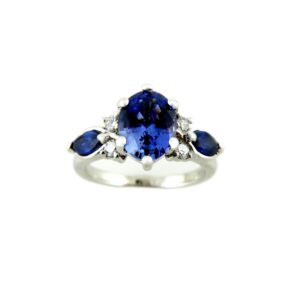
The Historical Significance of Gemstones
Gemstones have been prized for millennia. Egyptians used turquoise amulets as protectors, and Indian cultures equated gemstones with planetary forces. Medieval European monarchs wore rubies, sapphires, and emeralds to signify power and divine favor.
This heritage reminds us that gemstones are not simply pretty trinkets; gemstones are tied inextricably with spirituality, culture, and health.
The Spiritual and Healing Beliefs Behind Gemstones
They believe that gemstones possess vibrational powers that will enhance the wearer’s life. For example:
- Amethyst promotes peace and clarity.
- Rose Quartz signifies love, compassion, and healing.
- Citrine brings prosperity and confidence.
- Black Tourmaline is a negative energy shield stone.
There is no scientific evidence for these attributes, yet there are millions of people worldwide who do believe and utilize gemstones for their perceived metaphysical effects.
If you’re someone open to spirituality or alternative healing practices, gemstones might resonate strongly with you. On the other hand, skeptics may view them simply as beautiful natural creations.
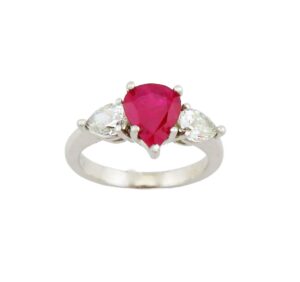
Astrological Importance of Gemstones
Astrologically, gemstones are believed to absorb the energies of planets and regulate one’s life path. The ruby, for example, is frequently associated with the Sun, symbolizing energy, leadership, and ego. Blue sapphire is similarly associated with Saturn, believed to impart discipline and focus.
Gemstones can be suggested by astrologers to strengthen favorable planets or suppress the negative effects of unfavorable planets. However, astrological gemstones should be worn only after consulting a learned astrologer because improper selection is said to create a negative impact in some cultures.
Are Gemstones Right for Everyone? Key Considerations
Although gemstones are beautiful and lovely, not everyone may be suited to wear them. These are some of the things to consider when wearing them:
1. Belief System
Wearing gemstones, if you believe in spiritual or astrological properties of gemstones, will provide you with peace of mind, confidence, and comfort. But if you don’t believe it, then you can very well wear gemstones for appearance’s sake.
2. Personal Style
Some individuals prefer traditional jewelry, while others prefer plain jewelry. Gemstones are extremely varied, and it is never a problem to acquire one of your preferences—whether flashy diamond or plain jade item.
3. Budget
Gemstones range from extremely affordable to extremely expensive. While diamonds, rubies, and sapphires fall into the luxury stones category, semi-precious gemstones such as citrine, garnet, or aquamarine are extremely cheap.
4. Ethical Concerns
Gemstone mining is usually marred by ethical and environmental concerns. Being a responsible consumer, it is best to buy certified, ethically mined gemstones.
5. Health and Safety
Some gemstones, primarily in raw or uncut form, contain particles of toxic minerals. Always buy from licensed jewelers and never touch suspicious gems.
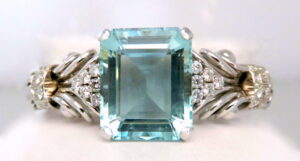
Who Should Wear Gemstones?
- Spiritual Seekers: People who are believers in energies, healing, and astrology would consider gemstones very significant.
- Fashionistas: Trend followers and those who love flashy jewelry and accessories can enjoy gemstones as long-term fashion accessories.
- Gifters: Gemstones are unique, customized gifts for birthdays, anniversaries, or milestones.
- Collectors: Others value gemstones as rare commodities and buy them as additions to collections.
Who May Not Benefit from Gemstones?
- Spirituality Skeptics: If you do not enjoy metaphysical or astrological concepts, you may not value the purported advantages.
- Minimalists: Individuals who are not fond of accessories or jewelry may not be interested in gemstones.
- Uninformed Buyers: Individuals purchasing on their own (particularly on astrological merits) may end up with the wrong stones.
Final Thoughts: Should You Try Gemstones?
So are gemstones for everyone? Yes and no. Gemstones are cherished by all because of how special they are, their beauty, and their symbolism. They can bring your fashion game up a level, be an energy tool, or be an investment. But whether or not they will do some metaphysical good for you will be based on what you believe, what you need, and your own choices.
Finally, gemstones are like any other symbol that symbolizes something to you if they are compatible with your lifestyle and values. Wearing them for fashion, astrology, or healing, gemstones can bring an element of poise and personality into your life.
If you’re ready to explore the perfect gemstone for yourself or as a thoughtful gift, Gem Boutique is here to guide you. With our carefully curated, ethically sourced collection, you’ll find stones that not only look stunning but also resonate with your personal journey.
Birthstones are more than just beautiful gems; they carry history, symbolism, and unique meanings. For those born in October, you’re lucky enough to have two dazzling gemstones, opal and tourmaline. Both stones are admired for their incredible colors, mystical charm, and healing properties, making them a favorite not only among October-born individuals but also jewelry enthusiasts worldwide.
If you’re asking yourself, “What are the October birthstones and what do they signify?” or “Can I wear an opal or tourmaline?” Then this article is for you.
What Are the October Birthstones?
October stands apart in that it has two official birthstones:
- Opal – Opal is also known as the “Queen of Gemstones” because it is valued for its play-of-color, in which veins of rainbow-colored color flash throughout the gemstone.
- Tourmaline – One of the few gemstones on earth that exist in almost every color of the spectrum, but most commonly in pink and green.
Each of the stones symbolizes love, imagination, and hope, but each of them with their own vibration and past.
Opal: The Iridescent Gem of October
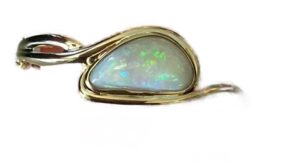
Opal is most definitely the most magical of gemstones, a dance of colors shimmering which change with the movement of the light.
Meaning and Symbolism of Opal
- Represents hope, innocence, and honesty.
- Historically used to inspire creativity and fantasy.
- Used in ancient times as a charm and shield.
Types of Opal
- White Opal – Most abundant, with milky background and vivid flashes.
- Black Opal – One of the most expensive and rare, with delicate color over dark background.
- Fire Opal – With orange, red, and yellow body color.
- Boulder Opal – With ironstone backing, giving natural contrast.
Healing Properties of Opal
Wear opal primarily for metaphysical qualities:
- Encourages emotional balance.
- Nurtures originality and creativity.
- Cultivates passion and love in love relations.
Tourmaline: The Rainbow October Gemstone
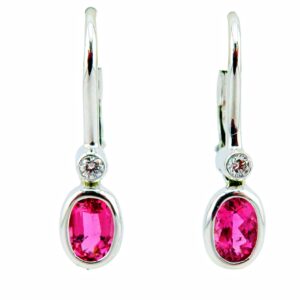
Tourmaline is popular due to its variety of colors. Its name came from the Sinhalese term “turmali,” or “mixed gems.”
Symbolism and Meaning of Tourmaline
- Represents compassion, friendship, and confidence.
- Thought to repel negative energy.
- Linked to balance and grounding.
Types of Tourmaline
- Pink Tourmaline – represents love and emotional healing.
- Green Tourmaline – is associated with strength, energy, and growth.
- Watermelon Tourmaline – shows both green and pink, which reflect happiness and harmony.
- Blue Tourmaline (Indicolite) – helps communication and spiritual connection.
Healing Properties of Tourmaline
- Impresses with positivity and peace of mind.
- Calms emotions and stress.
- Aids heart storage and boosts energy flow.
Opal vs. Tourmaline: Which October Birthstone Should You Choose?
If choosing between tourmaline and opal, take the following into consideration:
- Appearance: If you are a fan of color-shifting rainbow colors, choose opal. If you prefer single color or multicolor prominent stones, tourmaline is the one to choose.
- Durability: Tourmaline is slightly harder (7–7.5 on Mohs scale) than opal (5.5–6.5) and hence more suitable for everyday wear.
- Symbolism: Opal stimulates creativity and passion, and tourmaline stimulates balance and protection.
- Budget: Tourmaline is costlier on average, and black opals are extremely costly.
Lastly, both are gorgeous options and may complement other pieces of jewelry.
How to Wear October Birthstones
In the event you ever look and wonder “How can I wear opal or tourmaline?”, following are some appropriate options:
- Opal Jewelry: Ideal to wear as earrings, pendants, and rings. Because it is delicate, it evades strong impacts.
- Tourmaline Jewelry: Suits well in bracelets, necklaces, and engagement rings because of its hardness and color variety.
Taking Care of Your October Birthstones
Tourmaline and opal require maintenance to retain their loveliness.
Opal Care Tips:
- Steer clear of extreme heat or extreme temperature fluctuations.
- Keep separated from other stones to avoid scratching.
- Bathe gently in warm soapy water, never chemicals.
Tourmaline Care Tips:
- Clean with soapy water and gentle heat.
- No steam and ultrasonic cleaning.
- Keep separately from harder stones to avoid scratches.
Final Thoughts
October-born individuals are truly blessed with two extraordinary birthstones, the mystical opal and the versatile tourmaline. Whether you’re drawn to opal’s dazzling play-of-color or tourmaline’s wide spectrum of shades, both stones hold deep symbolism and timeless beauty.
If you need a special gift or simply desire to incorporate some personal, quirky style into your jewelry wardrobe, an October birthstone ring, pendant, or bracelet is the way to go. Not only do they make ideal accessories, but they also mean something very deep that will endure for years to come.
Given to you by Gem Boutique, we present to you our thoughtfully crafted gemstone jewelry, such as opal and tourmaline jewelry expressing your personality. Mark your birthday month with jewelry whose elegance, significance, and sophistication will endure.
Gemstones have played a tightrope role in the history of mankind, representing power, beauty, and, frankly speaking, mystical capabilities. The sapphire is one of them. Due to its intense blue glow, sapphire is the birthstone of September, and a favorite jewel of royalty, jewelry merchants, and collectors. A sapphire guarded you because you were born in September, or you are just interested in understanding more about this precious stone- this is your ultimate guide on everything you need to know about sapphire.
A Glimpse Into Sapphire’s History
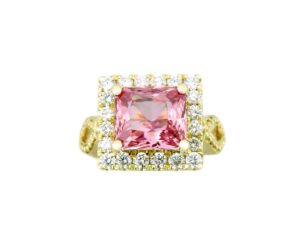
The fascination with sapphire dates back centuries. The Ancient Persians even thought that the sky was painted blue because of the reflection of sapphire. In Greece and Rome, royalty used sapphire jewelry as a guard against evil and jealousy. In the Middle Ages, the clergy adorned themselves with sapphires, as they believed that the gem was the representation of heaven. In contrast, warriors took them to battle as protective and fortune-bringing devices.
The connection of Sapphire with royalty is so close that the gem has also been termed a stone of kings. Its beauty, as well as its purported aphrodisiac qualities (which made kings appreciate it to the point of securing it to maintain fidelity and prevent seduction), made it a royal custom to invest in it. Its reputation for wisdom and goodness endures to date.
What Exactly Is a Sapphire?

Sapphire is a corundum mineral, making it the same family as rubies. The only distinction is that the red corundum is termed as ruby, whereas other colors can be categorized as sapphire. Although most often sapphire is a rich royal blue, the gemstone appears in a spectacular array of colors, including pink, yellow, orange, green, and even some colored sapphires are purple in hue or even black. White sapphires are also used as an alternative to the diamond, as are colorless sapphires, occasionally referred to as white sapphires.
Another equally rare sapphire is the Padparadscha (sometimes pronounced as Padparadja), which is a beautiful stone having a subtle pink-orange color resembling that of a tropical sunset. These are scarce gems, so their owner collectors prefer their unusual beauty.
Sapphire is ranked 9 out of 10 on the Mohs scale of hardness, which is one of the most resilient gemstones in existence. The strength of one stone is that sapphire jewelry can be worn every day, which is why it appears very often in engagement rings and pieces of heritage.
Symbolism and Meaning of Sapphire
The month of September is sentimental, being the birthstone of sapphire. In cross-cultural terms, it reflects:
- Wisdom and knowledge – thought to bring a logical frame of thought and a reasoned decision.
- Loyalty and faithfulness – often chosen for engagement rings as a symbol of enduring love.
- Protection – historically worn to protect against bad energies, jealousy, and betrayal.
- Spirituality – associated with truth, honesty, and divine favor.
Sapphire is synonymous with trust and sincerity, so it is an especially considerate gift, whether as a birthday, an anniversary, or a pledge of life-long commitment.
Famous Sapphires Through Time

There are sapphires so incredible, they have almost become mythical. The best known is ‘perhaps the 18-carat blue sapphire engagement ring first presented by Prince Charles to Lady Diana Spencer in 1981. In modern day, the tiara adorns the finger of Catherine, Princess of Wales, and is likely one of the most recognizable pieces of jewelry in the world.
Other well-known ones are the Star of India, a 563-carat sapphire in New York at the American Museum of Natural History. Known as the gem that heals the soul, this gemstone is also well known due to its rare asterism, or a star-like reflection created by needle-like inclusions within the stone.
Other famous sapphires, including the Stuart Sapphire in the British Crown Jewels, only emphasize the association between sapphire and royalty and the prestigious value.
How to Care for Sapphire Jewelry
Sapphires are so extremely hard that when they are cleaned and handled properly they shine through the ages:
- Cleaning – Warm water, mild soap, and a soft brush will carefully clean the stone. Ultrasonic cleaners are safe, in general, but cleaners are not recommended in case the sapphire is fractured or has inclusions.
- Avoid Harsh Chemicals – High Caustic chemicals like bleach, chlorine, or strong household detergents can destroy the stone or its setting.
- Storage – Although sapphires are hard, they too can be scratched through by other sapphires or diamonds. Keep them on their own in soft pouches or fabric-lined boxes.
- Regular Checkups – Visually inspect the setting of your sapphire in a ring or other piece worn frequently to make sure that the setting is intact.
Caring for sapphire jewelry is a straightforward procedure that can turn the jewelry into a childhood memory.
Read More: Sapphires Come in Different Colors
Why Sapphire Jewelry Is a Timeless Choice
The reasons why sapphires remain one of the most demanded gemstones are numerous:
- Versatility – Comes in a lot of colors to suit all modern and vintage jewelry decorations.
- Durability – They are hard and thus they can be worn every day without worrying about them being scratched or even destroyed.
- Symbolism – From love and loyalty to wisdom and truth, sapphires carry powerful meanings that resonate with people across cultures.
- Elegance – Attributable to the cool tone qualities, sapphires are very sleek, whether adored in a dainty pendant or a statement ring, the jewels always bring cool luxe to any ensemble.
Whether it is engagement jewelry or an anniversary gift, the sapphire is a favorite jewel since it is not only beautiful but also highly sentimental. Sapphires make an excellent addition to the jewelry collection, and with unique, hand-crafted designs available at the Gem Boutique, lasting craftsmanship and present-day excellence go hand-in-hand.
Final Thoughts
Sapphire is much more than a September birthstone- it is a gemstone steeped in history, culture, and eternal beauty. Adored by royalty, ancient civilisations, and a staple in modern jewelry, sapphires seem to have an everlasting story of devotion, wisdom, and beauty. This sapphire jewelry is a decision that will never come out of fashion, should you be celebrating your birthday in September, seeking a special gift, or buying an investment piece in a durable, strong, and attractive gemstone.
The art of jewelry making is a timeless declaration of personality, grace, and purpose, as embodied in beautiful pieces of jewelry, such as gemstone necklaces and pendants. A gemstone necklace is a perfect gift idea or something that can be bought for yourself, as it brings a certain meaning and shine to every situation.
Each handcrafted piece in our carefully curated selection of gemstones, with their diverse styles and applications, is a fine work of art, and it is at Gem Boutique in York, PA, that we proudly host.

Why Gemstone Necklaces Are Always in Style?
Gemstone jewelry has a reason not to have crossed the line. People started to wear colorful stones not only because they look good but also because they provoke certain emotions and associations. Throughout the centuries, from the times of the first civilizations to the present trendsetters, gemstones have been a kind of self-expression.
Every gemstone is a story, and we cherish it as such at Gem Boutique York, PA, where we choose our works not only because they are beautiful, but also because they have a feeling behind them, a symbolism attached to them.
Popular Gemstones in Our Collection
The necklace and pendant in our collection have a vast range of genuine gemstones:
- Emerald – Known for its rich green hue, emerald symbolizes renewal, growth, and prosperity.
- Ruby – Go-ahead and passionate, great at making statements.
- Sapphire – Classic and luxurious sapphire is associated with wisdom.
- Garnet – Deep red in color, garnet symbolizes strength, devotion, and energy.
- Tanzanite – Rare and vibrant, tanzanite reflects transformation, intuition, and spiritual growth.
- Pearls – Timeless and elegant, pearls represent purity, serenity, and sophistication.
- Amethyst – Beautiful purple color, fashion goods, and relaxing.
- Aquamarine – Ethereal, light blue, a sign of peace.
- Citrine – The warm yellow is seen to be positive and creative.
- Sapphire – Classic and luxurious sapphire is associated with wisdom.
Of course, Gem Boutique has a full line of both natural and lab grown diamonds in all shapes and sizes that set off any colored gemstone.
Every gemstone in our collection is hand-selected for its beauty and authenticity. You can check out our Gemstone Necklaces and Pendants here.
Finding the Right Necklace for Your Style

The kind of jewelry you should wear should represent you. That is why we present a lot of different styles that will fit every personality and every occasion:
- Bold Statement Pieces – These pieces are suited to special occasions as they are bigger stones or very elaborate pieces that just shout loudly.
- Delicate Chains with Subtle Gems – They would be great as your everyday jewelry due to their lightweight design with smaller stones, such as an aquamarine or amethyst, that have a modest yet significant style.
- Layered Necklaces – Add various ages, shapes, and styles of gemstone pendants to a layered necklace look to create your own unique, trendy look.
- Classic Solitaire Pendants – An elegant classic design that is beautiful and suitable for any situation; this pendant features just one gorgeous gemstone.
We have a staff at Gem Boutique York, PA, that would love to assist you in finding the best piece that suits your style and your spirit.
How to Wear Gemstone Necklaces for Any Occasion

Necklaces of gemstones can also be fashioned to fit any given style and occasion:
- Everyday Wear: Simple gemstone pendants such as amethyst, citrine, or pearl give you a touch of class every day, on working days, or casual days.
- Evening Events: Try that bigger piece of jewelry, such as garnet, sapphire, or ruby in a statement necklace or dangling earrings.
- Seasonal Styling:
- Spring & Summer: Aquamarine, blue topaz, or lemon stones that are not very bright
- Fall & Winter: Darker, richer colors such as garnet, emerald, or tanzanite
Our stylists will help you match your jewelry with the right outfit or season at any given moment.
What Makes Gem Boutique York PA Special?
The point of Gem Boutique is not only a jewelry shop but also a local spot, where people can find quality, originality, and someone who treats them individually. Each of our pieces is carefully curated, taking into consideration the quality of craft and the quality of gemstones to create a collection that looks good and means something too.
Whether you’re celebrating a birthday, anniversary, or simply want to treat yourself, you’ll find something unique in our Diamond Necklace and pendants collection.
Visit Us or Browse Online
Ready to explore the beauty of gemstone necklaces?
Browse our online gallery or stop by Gem Boutique to experience our collection in person. Whether you’re drawn to the soft elegance of pearls or the fiery sparkle of rubies, there’s a gemstone waiting to be part of your story.
August is one of the lucky months with more than one birthstone, and we are fortunate to have three: Peridot, Spinel, and Sardonyx. Every gem has its spice, symbolism, and flair to offer. Whether born in August or buying a gift for a flower child born in that month, knowing the story behind these gemstones can put the potential buyer in a better position to find something more special, better aligning with the person in question.
August babies are torn between these two beautiful stones at Gem Boutique on a regular basis, and it is not surprising. These birthstones allude to a diverse range of personalities and tastes, spanning from bright and playful greens to mysterious reds and earthy elements.

Peridot: Bright, Bold, and Full of Good Energy
The most representative of the birthstones in the month of August is Peridot. It is a dark green colour that is completely natural, i.e., it derives its colour due to the mineral olivine. Peridot, unlike most gems, owes its color to its chemical composition rather than trace elements.
What It Symbolizes:
Peridot is called the sun gem and symbolizes protection, peace, and emotional clarity. The Ancient Egyptians thought that it might chase away evil and cause happiness.
Why People Love It:
The refreshing green color suits any skin type, and it gives natural vibrancy to an outfit. It appears exclusively breathtaking when it is placed on yellow gold or silver.
Jewelry Tip:
Peridot is not as hard as other stones; hence, it would be ideal in earrings, pendants and rings that are worn with care. We at Gem Boutique are providing in-house jewelry repairs and resizing skills of rings in York, PA, so you can keep your choice of the Peridot in place and gleaming over the years.
Spinel: Rare and Radiant

Having long been confused with rubies, Spinel is finally being given the props it deserves. It is also available in a huge variety of shades, including deep reds and pinks, and also purple colors or even blue.
Meaning Behind the Stone:
Spinel represents the powers of inspiration, renewal, and energy. People tend to consider it a jewel of a transition – any person who is going through a new stage in life is welcome to take it.
Why It’s a Great Choice:
Spinel is a bright, hard (Mohs 8) stone, and so would be a convenient piece of jewelry to wear on a regular basis. It also costs less as compared to the appearance of a rock such as ruby or sapphire.
Design Idea:
Looking for something daring but not too pizzy? A Spinel ring with red or lavender colour is a timeless piece of art with a surprise.

How to Choose Your August Birthstone
With the August gem, you will have something slightly different. It might come to your choice because of your style, or even your values, or even the type of energy you desire to attract.
- Go for Peridot if you love joyful, sunny energy and nature-inspired colors.
- Choose Spinel if you’re drawn to something rare, colorful, and full of hidden brilliance.
- Pick Sardonyx if tradition, strength, and earthy tones are more your style.
Naturally, you are not to be limited to a single one! At Gem Boutique, numerous of our clients prefer to mix stones in a layering kind of meaning or family jewelry.
Care, Repair, and Customization – All in One Place
No matter which August birthstone you choose, your jewelry deserves care and attention. At Gem Boutique, we’re proud to offer in-house jewelry repair and ring sizing services in York, PA — including setting inspections and gemstone polishing.

























